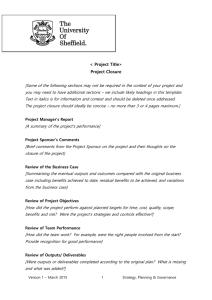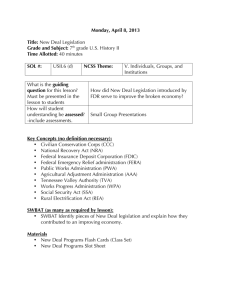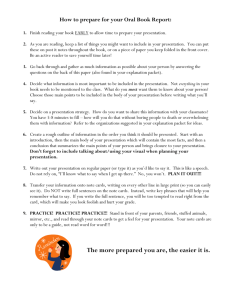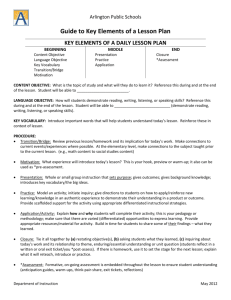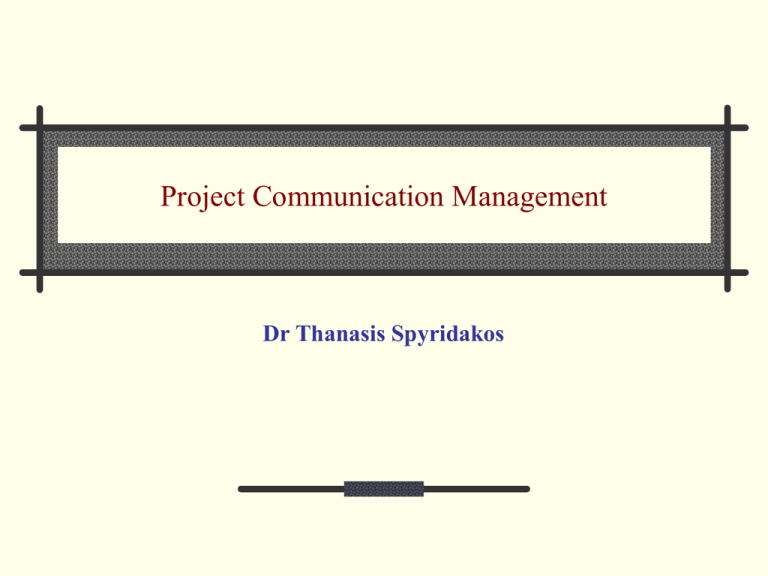
Project Communication Management
Dr Thanasis Spyridakos
Overview
Introduction
Course Overview and Objectives
Project Communication Management: Communication
Planning, Information Distribution, Performance Reporting,
Administrative Closure
Management Communication in Transition
Course Description
Understand and develop the oral and written communication
skills
Learn how and develop and implement a detailed project
communication plan for all the Phases
Acquire knowledge concerning the appropriate methods,
techniques and practices used for project communication taking
into consideration the characteristics of every project.
Goals
Create and execute a project communication plan
Use appropriate information resources
Articulate Cleary your project communications
Assess how intercultural and information issues affect business
and project communications
Evaluate your communication style
Assess the value of communication styles and respond
appropriate
Understand and apply good virtual communication skills
Select an appropriate communication media
Concepts
Communication planning
Information Distribution
Performance Reporting
Administrative Closure
Project Manager as leader,
manager, facilitator and
mentor
Managing project conflicts
Communication during the
stages of a project
Project manager awareness of
self
Managing team performance
Interpersonal
communications
Motivating team members
Basics of Knowledge
management
Business writing
Communications at work
Communications effectively
via e-mail
Communication strategy
Communication ethics
Conducting research on line
Effectively summarizing
material
Designing successful
documents for work
Writing proposals
Developing effective
presentaations
Project Communication Management
Includes the processes required to ensure timely and appropriate
generation, collection, dissemination, storage, and ultimate
disposition of project information.
Critical links among people, ideas and information
All the involved actors must be prepared to send and receive
communications
Must understand their involvement as individual and their
affects on the project
Resources
Flannes, S.W, G. Levin (2001), People skills for Project
Managers, Management Concept
Project Management Institute (2000), A Guide to the Project
Management Body of Knowledge
O’Rourke, J. (2004), Management Communication: a caseanalysis approach, Pearson Prentice Hall.
Kolin, C.K. (2004), Successful writing at work, Houghton Mifflin
Company. Boston
Major Processes (1)
Communication Planning – Determine the information and
communication needed- WHO - WHEN - HOW
Information Distribution – making information available to
project stakeholders
Performance Reporting – Collecting and disseminating
performance information
Administrative Closure – generating, gathering and
disseminating information to formalise a phase or project
completion
Project Communication
Management
Communication
Planing
Information
Distribution
Performance
Reporting
Administrative
Closure
Major Processes (2)
There is a high degree of interaction among the four discrete
processes
In practice there is an overlapping and interaction
Also, the Project Management Skills of Communicating is
related to (not the same) with the project communication
management
A substantial body of knowledge is required (not unique for the
project context)
Communication Planning
Input:
Communication requirements
Communication Technology
Constraints
Assumptions
Tools and Techniques
Stakeholder Analysis
Outputs
Communication Management Plan
Communication Planning
Project Communication Requirements includes
Project organisation and stakeholders responsibility
relationships
Disciplines, departments and specialties involved in the project
Logistics of how many individuals will be involved in the project
and at which location
External Information Needs
Communication technology
Keypoints:
Immediacy of the need of information
Availability of Technology
Expected project staffing
Length of the project
Communication Planning
Stakeholder Analysis:
Develop a methodical as logical view of the information needs
Avoid wasting resources and the use of not appropriate technology
Communication Management Planning
A collection of filling and details of methods for gathering and storing
infromation
A distribution structure (to whom, what method, which information).
Take care the responsibilities and reporting needs.
Description of the Information to be distributed.
Production Schedules
Methods of assessing information
Method to evaluate, update and refine the plan
Information Distribution
Inputs
Work Results
Communication management plan
Project Plan
Tools and Techniques
Communication Skills
Information Retrieval System
Information Distribution methods
Outputs
Project records
Project Reports
Project Presentations
Communication Skills
Communication Skills (Dimensions)
Written and oral, listening and speaking
Internal and external
Formal and Informal
Vertical (up and down) and horizontal (with peers)
Performance Reporting
Input
Project Plan
Work results
Other prject records
Tools and Techniques
Performance Review
Variance Analysis
Trend Analysis
Earned value analysis
Information distribution toools and techniques
Outputs
Performance Report
Change requests
Performance reporting
Process invcludes: Status reporting, Progress reporting,
Forecasting
Administrative Closure
Inputs
Performance Measurement documentation
Product Documents
Other project records
Tools and techniques
Performance reporting tools and techniques
Project reports
Project presentations
Outputs
Project archives
Project closure
Lessons learned
MANAGEMENT COMMUNICATION IN
TRANSITION
“Communication is the work of managers, day in and day out.”
I.
A.
The daily work of managers.
Managers are in constant action.
1.
Switch frequently from task to task.
2.
Change their focus of attention to respond to issues as
they arise.
3.
Engage in a large volume of tasks of short duration.
B. Managers spend most of their time interacting with others.
1.
Engage in interactions both inside and outside the
organization.
2.
Talk and listen when in action.
Management Communication in Transition
II. The majority of managers cluster around three core
management roles.
A. Interpersonal roles are the richest source of information for
managers because of their immediate and personal nature.
1. The figurehead role is exhibited when performing
ceremonial duties of their position.
2. The leader role is exhibited when demonstrating their
responsibility for the work of the people in their unit and their
actions. This is where the influence of managers is most clearly
seen.
3. The liaison role is exhibited when establishing and
maintaining contacts outside the vertical chain of command.
Management Communication in Transition
B. Informational roles of managers are required because not
even the most expensive management information system can
match the speed and intuitive power of a well-trained manager’s
brain for information processing.
1.
The monitor role allows managers to scan the
environment for information.
2.
The disseminator role allows managers to pass
privileged information directly to subordinates.
3.
The spokesperson role allows managers to send
information to people outside of their organizations.
Management Communication in Transition
C. Decisional roles are used by managers to make decisions on
behalf of the organization and the stakeholders with an interest
in the organization.
1. Interpersonal and informational roles often aid the
decision making process.
2. The entrepreneur role is shown when managers seek to
improve their businesses, to adapt to changing market
conditions, and to react to opportunities as they present
themselves.
3. The disturbance or crisis handler role depicts managers
who must involuntarily react to conditions.
4. The resource allocator role involves managers making
decisions about who gets what, how much, when, and why.
5. The negotiator role is used to resolve disputes with people
inside and outside the organization.
Management Communication in Transition
III.
Although the specificity of managers’ work may differ, there are a
few major characteristics relating to every job.
A. The time of managers is fragmented. This often drives managers
to overwork and can force them to complete tasks superficially.
B. Values compete and the various roles are in tension placing
managers in the middle when making many decisions. Managers
cannot satisfy all parties involved, thus decisions are often based on the
urgency of the need and the proximity of the problem.
C. The job of managers is overloaded due to significant
reorganization efforts to make businesses more efficient, nimble, and
competitive. Downsizing, coupled with high-speed data processing and
remarkably efficient telecommunication systems has greatly increased
the number of people directly reporting to managers.
D. Efficiency becomes a core skill for successful managers.
Management Communication in Transition
IV.
The emphasis of management roles is what varies in a
manager’s job.
A.The role of the entrepreneur is gaining importance as
managers become increasingly aware of threats and
opportunities in their environment. Managers who are carefully
attuned to the marketplace and competitive environment will
look for opportunities to gain an advantage.
B. The leader role is gaining importance as managers must
become more sophisticated as strategists and mentors.
Managers need to become more active mentors to attract and
retain skilled employees.
C. Managers must create a local vision as they help people within
their organization to grow.
Management Communication in Transition
V. The 21st century workplace will require three types of skills, each
of which will be useful at different points in your career.
A. Technical skills are most valuable at the entry level, but less
valuable at the senior levels. These skills constantly change and
become outdated.
B. Relating skills are valuable across the managerial career
span and are more likely to help you progress and be promoted
to higher levels of responsibility. These skills help you form
relationships with people both inside and outside of the
organization.
C. Conceptual skills are the least valuable at the entry level,
but more valuable at senior levels in the organization. These
skills permit you to look past the details of everyday work
assignments and see the bigger picture.
Management Communication in Transition
VI. Talking is the work of managers.
A. One-on-one conversations allow an enormous exchange of
information.
B. Managers spend an astounding amount of time on the telephone.
The amount of time per telephone call is decreasing, but the number of
calls per day is increasing.
C. Video teleconferencing makes direct conversations to people
around the world a simple matter. These exchanges can be informal,
conversational, and not much different than if the parties were in the
same room.
D. Managers give many presentations to small groups of three-toeight people in both a formal and informal manner.
E. Most managers are often required to speak to larger audiences of
several dozen, or perhaps, even several hundred. These presentations
are often more formal but still involve one manager talking to others,
framing, shaping, and passing information to an audience.
Management Communication in Transition
VII.
Writing plays an important role in the life of any
organization.
A. Managers use writing as a career sifter; if you do not
demonstrate your ability to put ideas on paper in a clear,
unambiguous fashion, you will most likely not last.
B. Managers at all levels of most organizations draft, review,
edit, and dispatch their own correspondence, reports, and
proposals.
C. When a document leaves your desk, it takes on a life of its
own. Documents become the property of the organization they
are sent to and therefore they are free to do as they see fit with
your writing.
D. Managers create meaning through communication, thus
communication is invention.
Management Communication in Transition
VIII. Information is socially constructed.
A. Information is created, shared and interpreted by people.
B. Information never speaks for itself; it almost always
requires some sort of interpretation, explanation or context.
C. The context of a message is always of paramount
importance to the listener, viewer, or reader in reaching a
reasonable conclusion about what she sees or hears.
D. If the messages you send as a manager are to have the
impact you hope they will, they must come from a source the
receiver knows, respects, and understands.

